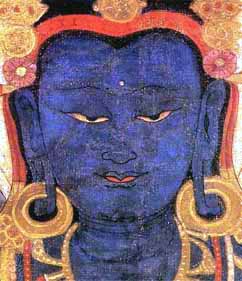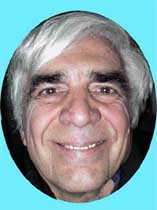
"Why
Is The Buddha Smiling"
by Ramon Sender Barayon
updated
11/28/03 (see images below)
In November, 2001, I discovered a personal portal to no-mind. It all started when I raised my eyes from the computer monitor at the office and looked out the high window above it into the treetops. I noticed that it triggered a glow of pleasant energy that spread gradually into my fingertips. At first I thought that I must be storing up a lot of tension around my eyes when I focused on the screen. Then I thought, "No, it must be some sort of 'one o'clock high' from raising my widened eyes to the one o'clock position. I began to try to 'stare in amazement' more, pretty easy these days what with the way our consensus reality is fraying.
Upon returning home, I studied the face of the Buddha on my wall with renewed interest. The Buddha's eyebrows were slightly raised, his eyelids half-drooping, and the corners of his mouth turned up in a half-smile. I asked myself, "Do these icons" expressions contain teachings?" Perhaps their postures, expressions and gestures should be copied. I tried the Buddha's facial expression, and lo and behold, it triggered the same energy wave -- but even stronger.
Could this be a gateway to a transpersonal state? Of course it's always possible that I've been unknowingly so up-tight for years that I don't feel what everyone else is feeling all the time -- this lovely coursing of energy from the solar plexus into the heart area and then out through the fingertips. If this is normal for everyone else, then I've certainly been missing out! How unfortunate that we don't have a universal bliss-ecstasy scale similar to blood pressure or temperature. Perhaps the unit could be named 'a ramana' after the great Indian sage who spent almost his whole lifetime in ecstasy. Ramana 10 could be the ultimate state, and then we could go all the way down to Ramana -10, which could represent a total enmeshment with the IRS long form. Zero should symbolize something like a relaxed state after a pleasurable work-out -- or after sex.
Since what I now consider this first subtle energy awakening, I've delved further into the facial expression depicted on various Buddhist icons, read further into Taoist yoga, advaita instructions, and interviewed friends who meditate. But I always return to the Buddha's smile, and have begun to formulate my own answer -- one that at least makes sense to me. Buddha is meditating on the void created by holding a slight vacuum between his tongue and his soft palate. In other words, he"s nursing on his uvula. Try it yourself.
At night, before sleeping, I lie on my back with my eyes focused gently "distant and wide" between my eyebrows, a position that seems to keep me from wandering in my thoughts. I create a vacuum in the back of my mouth by sucking in my cheeks, and smile "up" so that I crinkle my eyes, flare my nostrils and raise my eyebrows slightly. Then I cluck away on my uvula, hoping that my dear wife won"t awaken to what a cluckhead she"s married. What great results!
The very best time to try out this facial "gesture is the moment
you awaken in the morning. Uvula-nursing involves the same mouth movement and
sound that babies make when they nurse in their dreams. I rest my tongue with
the tip between my teeth, while depressing the soft palate and glottis
rhythmically to create a sucking pulsation in the back of the mouth.
Let's practice it together. First try the three tongue "clicks' on
the inhale through the smiling open mouth.
The "Tst" tongue-tip-between-the-front-teeth click.
The "Tck" tongue click against hard palate just behind the front
teeth.
The glottal "Tlok" tongue click against soft palate in the back of
the mouth.
The "Tst" is a sound I frequently make when encountering a toddler because it usually elicits a smile or an answering click. I think it amuses them because it reminds the child unconsciously of the closed-mouth nursing 'cluck.' The only other use I can think of for these 'clicks' in English is for 'giddy-upping' a horse -- 'tlok-tlok-tlok'. I use it to encourage my terrier to jump in the back seat from the sidewalk.
Now move to a closed-mouth, smiling, muted 'cluck'. You will notice that the 'cluck' is a little harder to make in the same manner, but if you position the movement along the full length of the tongue, you are duplicating the movement of a nursing baby, and your 'cluck' is coming from further back in the throat. If you practice in front of a mirror, you will notice that the front of the throat moves with the clucking sound.
Now apply suction between the tongue and the palate as you cluck. Try to 'cluck' in time with your heartbeat. Feel the waves of energy that clucking in this manner triggers all the way down to below your navel.
Another way to rehearse this is copying the sound that some gecko lizards make - "geck!" Say it, then repeat it with the mouth closed. Repeat it again with the mouth closed, but on the inhale. That seems to position it accurately. The geck can be divided into two sections. The application of suction to the soft palate region, and then the release. Hold a 'half-geck' a few seconds and contract the external anal sphincter in what has become known as "the Kagel exercise." Include movng the diaphragm up and in towards the spine. In yoga this is called "the mulabandha,' and also is practiced in Taoist yoga in a variety of quite sophisticated exercises. Notice also how applying suction to the roof of the mouth subtly shifts the energies in the head area and -- at least for me -- keeps me far outside my thoughts.
Another refinement: stick out the tongue, clamp your teeth on it just
hard enough to hold it in place but not to cause pain.
Inhale deeply through the nose. When you exhale, smile, pull back on your
tongue but continue to hold onto it. On the next inhale, release the pressure.
Exhale, smile and pull again. Pull as hard as you can without causing pain. Add
the tongue clamp to the nursing movement. They go quite well together. Again,
as in the nursing 'cluck,' there's a natural tendency to clench the anal
sphincters on the pull. Try it, and again pull the diaphragm muscle in and up
on the exhale.
Once you have re-learned -- and I say 're-learned' because we all did this as babies -- this exercise, you can refine it to a more and more subtle -- and silent -- movement inside the mouth. Finally it can become subtle enough that you can practice it as a fast pick-up at your next committee meeting, sort of like an invisible cough drop. Same with the tongue clamp. The tip of the tongue can be held between the teeth behind closed lips, and no one will be the wiser. Actually it's a 'gesture' sometimes made when we are concentrating hard on a delicate task, such as threading a thread through a small needle.
Herman Hesse, in his novel on the Buddha, "Siddhartha," writes: "Siddartha sat absorbed, his eyes staring as if directed at a distant goal, the tip of his tongue showing a little between his teeth."
UPDATE (6/20/03): Yesterday, browsing a catalogue from an exhibit of Buddhist art, I ran across the following:

Detail from "Akshobhya With
Retinue," Zimmerman Family Collection, reproduced in
"Buddha - Radiant Awakening," published by the Art Gallery
of New South Walesand VisAsia,
in conjunction with the exhibit that opened the in November, 2001.
I traced over the outlines of both lips to emphasize them, but this is the most unique image that I have found to date that displays a Buddha with his tongue showing. Returning to Hesse"s description, in order for the tip of the tongue to "show" between the teeth (if the teeth also are seen), the lips have to be parted. Try it. It requires a smile. Even in the image above (tongue with no teeth showing), a subtle smile is displayed. Although I have yet to discover a "bared teeth" smile in any of the sculptures or paintings of the Buddha, perhaps Hesse saw this particular thangka. His "distant goal" suggests a gaze that is not abstracted, but focused far-away. I"ve heard that state described "as a cat watching a mouse-hole," or that of a deer alert to a distant movement in the forest.
Summing up, if you have any doubt as to the efficacy of this nursing exercise, I suggest you practice it the moment your eyes open in the morning. Do a fast series of ten clucks, clamp the tongue and stretch it on the inhaled breath with the accompanying Kagel exercise. I think you will be pleasantly surprised by the results. Once again, I warn the reader to go slow and be gentle. Ease up at the first sign of discomfort. But in my humble opinion, once these energies have been experienced, you now will own a potent tool for remaining outside and above your mind during meditation by surfing on the waves of oceanic being that you innately are. Let me know how it works for you, because more exercises will follow.

Ramon attempting The Smile updated 11/28/03
